Hung Teng-hsing (洪登興) could spend all day talking about the miracles he’s seen.
“You might not believe what I tell you, but only people who have seen or experienced miracles know how it feels,” Hung says.
Even the founding of his Ling An Temple (靈安宮) was a miracle, he says. Under the instructions of patron deity Qingshanwang (青山王, or “Green Mountain King”), Hung’s family moved from Taipei’s Wanhua District (萬華) to then-Banciao City (板橋) in 1979 and set up a small shrine on the third floor of their small apartment building. As their followers increased, Hung’s father prayed for a proper temple.
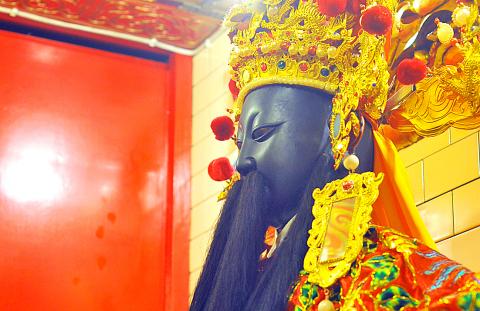
Photo: Han Cheung, Taipei Times
Soon, the brother of a woman they knew came by and asked if they were looking for a place.
“We asked how he knew, and he said a middle-aged man told him,” Hung says. “Nobody knew who the middle-aged man was. We first rented it, then bought it in 1980 and converted it into today’s temple. Nothing has changed much in 37 years.”
After holding only two religious processions for Qingshanwang’s birthday between 2005 and 2014, Hung resumed the formerly-annual event two years ago, with this year’s event falling on Sunday. Tomorrow, Hung will give a presentation in Chinese on the history of the temple and its unique bajiang (八將) troupe, not to be confused with the more common bajiajiang (八家將) or “Eight Generals,” will demonstrate and explain their performance steps and techniques.
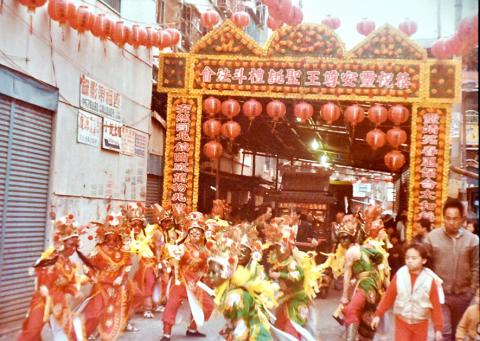
Photo courtesy of Ling An Temple
Qingshanwang’s birthday is actually on Dec. 10, but Ling An Temple is hosting the procession a week earlier to avoid coinciding with Qingshan Temple’s procession as they have a number of shared performers.
COMMUNITY SPIRIT
As the name of the temple’s deity suggests, Ling An Temple originates from Wanhua’s Qingshan Temple (青山宮). Built in 1856, Qingshan Temple ultimately originates from China’s Huian County in Fujian Province. The deity Qingshanwang was a benevolent Chinese general in real life, either living about 1,800 or 1,100 years ago, depending on the version of the story.
Hung’s family lived within a maze of winding alleys off today’s Dali Road (大理路), and the Qingshan Temple’s procession route used to skip their area. Hung Teng-hsing ’s father, Hung Ting-fa (洪定發), gathered a few men and collected money from neighbors to host their own birthday celebration with a Taiwanese opera troupe and “borrowed” a Qingshanwang statue from the main temple.
After several years of celebrations, the community carved its own Qingshanwang and built a temple to house it. Named Hungfu Temple (鴻福宮), it has since been moved to Xizang Street (西藏街). Qingshanwang chose Hung Ting-fa as its first spirit medium.
In 1979, Hung Ting-fa received a message from Qingshanwang asking him to expand the deity’s influence southward. Hung uprooted his family and moved to Banciao, where he set up the aforementioned shrine that eventually turned into today’s Ling An Temple.
FAMILY TRADITION
The temple stopped its annual processions for the first time in 2000 due to the 921 Earthquake and again in 2005 after the death of Hung Ting-fa. Hung Teng-hsing thought it would be a good idea to restart the event in 2015 to celebrate the temple’s 35th anniversary. Hung says it costs about NT$1 million to hold a procession — this is without inviting any other temples.
As a much smaller establishment with fewer resources, Ling An Temple’s procession will be much smaller compared to next weekend’s Qingshan Temple celebrations. But it covers the basics of such events with nine troupes, including Taiwanese lion dancers, flower drum arrays and, most importantly, the bajiang troupe that serves as Qingshanwang’s bodyguards.
Tsai Ming-li (蔡明利) concluded his 30-year career with the troupe in 2014, passing on the torch to his nephew. Tsai says bajiang members are carefully selected for dedication and temperament.
“Our steps, clothes, face paint and roles are all different,” Tsai says, as he displays a wall of weapons and ancient torture devices wielded by the bajiang troupe.
Hung says that their face paint is slightly different from that of the parent temple because they first commissioned the leader of a theater troupe to design them, eventually becoming a unique new style.
The temple is still waiting for a new spirit medium, however, as Hung says they can only be appointed by Qingshanwang. While the temple cannot perform certain services, Hung says it remains quite popular.
“It’s mostly by word of mouth,” he says. “One person comes here and finds that it works, and they’ll go tell their friends and family.”

Aug. 25 to Aug. 31 Although Mr. Lin (林) had been married to his Japanese wife for a decade, their union was never legally recognized — and even their daughter was officially deemed illegitimate. During the first half of Japanese rule in Taiwan, only marriages between Japanese men and Taiwanese women were valid, unless the Taiwanese husband formally joined a Japanese household. In 1920, Lin took his frustrations directly to the Ministry of Home Affairs: “Since Japan took possession of Taiwan, we have obeyed the government’s directives and committed ourselves to breaking old Qing-era customs. Yet ... our marriages remain unrecognized,
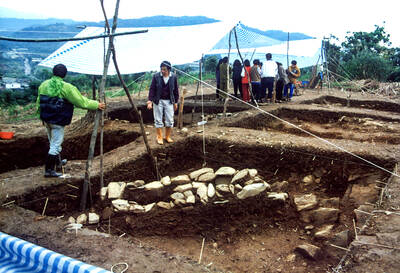
During the Metal Ages, prior to the arrival of the Dutch and Chinese, a great shift took place in indigenous material culture. Glass and agate beads, introduced after 400BC, completely replaced Taiwanese nephrite (jade) as the ornamental materials of choice, anthropologist Liu Jiun-Yu (劉俊昱) of the University of Washington wrote in a 2023 article. He added of the island’s modern indigenous peoples: “They are the descendants of prehistoric Formosans but have no nephrite-using cultures.” Moderns squint at that dynamic era of trade and cultural change through the mutually supporting lenses of later settler-colonialism and imperial power, which treated the indigenous as
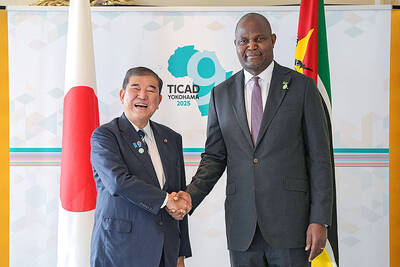
An attempt to promote friendship between Japan and countries in Africa has transformed into a xenophobic row about migration after inaccurate media reports suggested the scheme would lead to a “flood of immigrants.” The controversy erupted after the Japan International Cooperation Agency, or JICA, said this month it had designated four Japanese cities as “Africa hometowns” for partner countries in Africa: Mozambique, Nigeria, Ghana and Tanzania. The program, announced at the end of an international conference on African development in Yokohama, will involve personnel exchanges and events to foster closer ties between the four regional Japanese cities — Imabari, Kisarazu, Sanjo and
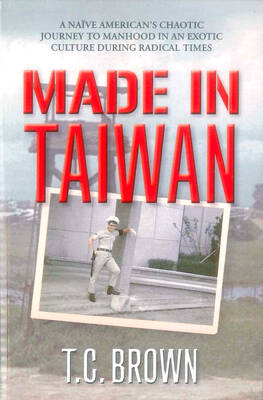
By 1971, heroin and opium use among US troops fighting in Vietnam had reached epidemic proportions, with 42 percent of American servicemen saying they’d tried opioids at least once and around 20 percent claiming some level of addiction, according to the US Department of Defense. Though heroin use by US troops has been little discussed in the context of Taiwan, these and other drugs — produced in part by rogue Chinese Nationalist Party (KMT) armies then in Thailand and Myanmar — also spread to US military bases on the island, where soldiers were often stoned or high. American military policeman